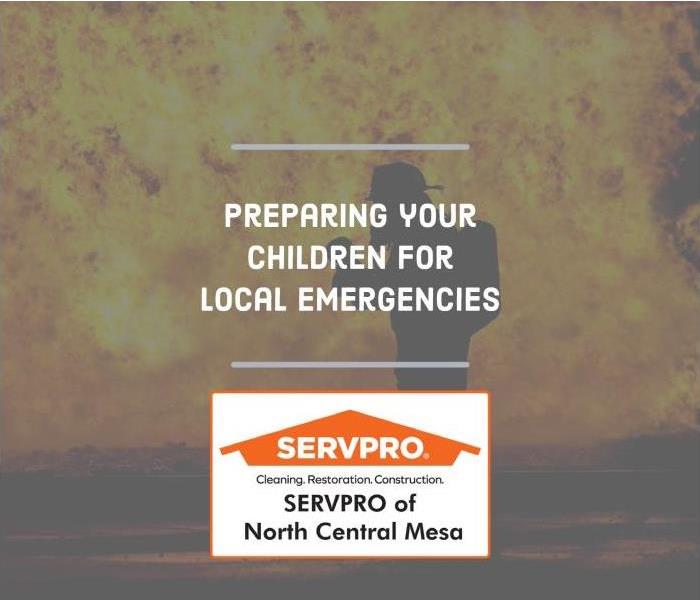Preparing Your Children for Local Emergencies
11/24/2021 (Permalink)
I remember when I was watching the 1989 World Series between the Los Angeles Dodgers and the Oakland A's with my youth group. I was living in Bakersfield, CA at the time which is about 5 hours south of the bay area where a major earthquake in the middle of game 3 on a Wednesday night. We had a long discussion about what we would do as a group to support each other if we were in that situation. Growing up in California we had tons of drills to prepare for what to do if an earthquake hit because we were always told the next major earthquake was "just around the corner." After living in California most of my life my family moved out to Florida right after hurricane Andrew and we dealt with several hurricanes, Tropical Storms, and other crazy flooding events during my time there.
Now that I am raising my family in the Mesa, AZ area my kids don't have the earthquake drills or hurricane drills I had growing up. The other day I was thinking to myself, would they know what to do if a major natural event happened here? Would they know what to do if a massive monsoon hit our area and my wife and I weren't there to tell them what to do?
Will your youngster know what to do if the unexpected happens? Disaster may hit anywhere, and it's usually with no notice. If your kid is put in an emergency scenario and doesn't know what to do, they could be severely harmed or experience serious anxiety for years afterward. In the event of a catastrophe, your child can feel more secure, confident
Preparing Our Children
In the end, educating our youth about preparedness tactics and advice requires the assistance of everyone in the community. Children will learn the significance of a crisis and strive to become classroom and neighborhood leaders, ensuring that everyone is ready for the next catastrophe if everyone contributes their part. The United States Department of Education, the American Red Cross, and the Federal Emergency Management Agency (FEMA) have collaborated to develop the National Strategy for Youth Preparedness Education, which lays out a vision for prepared kids in the United States and how communities may realize it. This paper aims to educate young people and their parents so that communities may better
With 10 easy steps, you can prepare children for emergencies and disasters.
The National Strategy describes nine essential phases that individuals and organizations at all levels of government should follow in order to form a strong and prepared youth community. Here's how you can help your children prepare for a variety of emergencies and catastrophes:
- Make it a priority. Making youth preparedness learning programs in schools and civic groups more important enables youngsters to comprehend that being ready is essential in all aspects of their lives.
- Examine. If existing youth preparedness programs aren't sufficient, design instructions, tools, and up-to-date protective measures to ensure that the children in your community are given sound guidance.
- Support. Parents should engage with communities, local organizations, and schools to prepare their children for an emergency along with other parents in the community.
- Connect. Create a connection between local youngsters and the first responder community. As a result of this, your children will be more understanding of how first responders act in an emergency scenario, and they will be more inclined to assist them.
- Prepare. Allow your children to become advocates in their neighborhoods and schools to prepare for emergencies before they happen.
- Make Family preparedness key. Schools, by their nature, promote broad community participation, so promoting family-based preparedness activities that include curriculum, drills, and specific exercises for all local disasters in the home and in the community can help your children understand what to do when faced with an emergency.
- Improve Communication. Coordinate efforts among families, churches, and community organizations to obtain up-to-date information on youth readiness best practices for your community. Local officials can also act as advocates by discussing your region's demands, particularly if it is vulnerable to natural calamities.
- Social Media. Identify how you can incorporate youth preparedness education into youth culture. Use social media or local advertising to start a discussion about the value and efficacy of preparedness programs, for example.
- Create. Create a long-term approach that recruits, trains, and delivers useful programs to teach kids in your area. Because certain places are known to experience recurrent natural calamities, it's critical to develop a strategy that is tailored to your community's demands.
Your children can get training to feel secure in the face of a disaster if you follow these nine priority steps. When disaster strikes, having the skills they need to understand how to prepare for, respond to, and rebound from a variety of disasters might make all the difference.
The Mesa, AZ Community Emergency Response Team (CERT) Program provides Mesa AZ area citizens with opportunities to learn basic emergency response skills.
Use SERVPRO's free Emergency Ready Plan App to work with children to prepare for emergencies in the home and let them share their experiences with their neighbors. SERVPRO's Emergency Ready Plan (ERP) app is available free of charge in the Google Play and Apple IOS App Store.






 24/7 Emergency Service
24/7 Emergency Service
